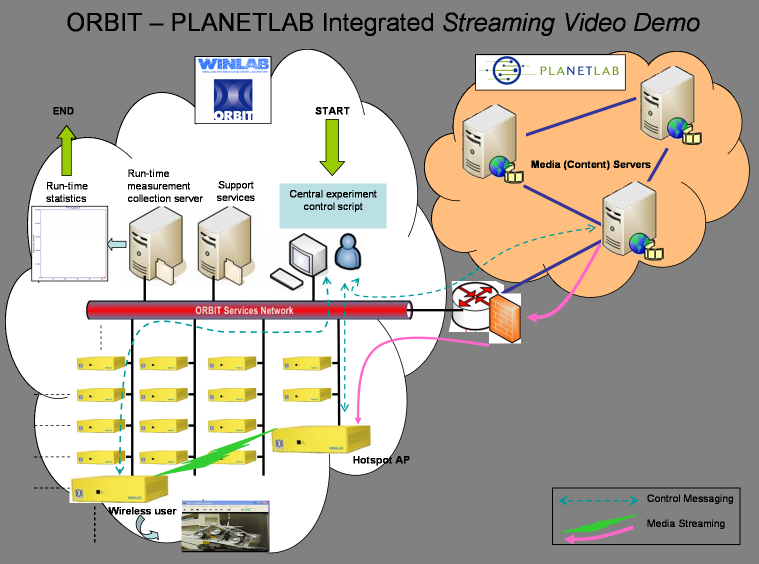Orbit > Planetlab-ORBIT Integrated demo
Planetlab-ORBIT integrated demo
Revision History
| Version | Date | Revised by | Changes |
| v0.1 | 2006-06-04 | Sachin Ganu | Initial version |
Objective
The objective of this demo is to show the federation of the two heterogeneous testbeds: Planetlab and ORBIT. This demonstration illustrates a typical wireless hotspot scenario with one node in the ORBIT testbed fetching video media off a remote Planetlab node and serving it to a fixed and mobile client.
The demo has been choreographed to use nodes 17-2 and 17-7, where 17-2 is the hotspot AP that fetches the media content off a remote Planetlab node pli2.pa-1.hpl.hp.com and serves it to node17-7 as well as the robot based mobile node.
Bitrate (in kbps) is measured by the receiving node and reported to the ORBIT infrastructure using the OML library.
A representative picture of the scenario is shown below
Steps to Execute Demo
- Image name — planetlab-biggrid.ndz. Resides on repository2:/export/orbit/image.
- Log onto console.grid.orbit-lab.org using ssh (see HowToGetStarted)
- Execute the following command on console.grid.
imageNodes [17,2],[17,7] planetlab-biggrid.ndz
- Download the tarball nodehandler-planetlabdemo.tar.gz from the link provided at the bottom of this page
- After extracting the tarball in your home directory,
cd nodehandler/src/ruby ruby handler/nodeHandler.rb -k test:exp:planetlab
- Display machine
On the display machine, point your Internet Explorer or Mozilla Firefox browser to http://internal3.orbit-lab.org/planetlab.html. This page should automatically populate the database name based on the current experiment id, and after selecting bitrate and wireless client, and clicking on Submit, you should be able to see the estimated measure of the bitrate at which the video stream is being played in kbps. Whenever the media content is relatively static, the bitrate is low, when there is more action, the bitrate is higher.
Prerequisites
- You need to have established ssh keys with the Planetlab server that is hosting the media stream (in our case, pli2.pa-1.hpl.hp.com)
In order to do so, run the following from console.grid
ssh-keygen -t rsa
This will prompt you for a passphrase and you can choose to save this key-pair to file called planetlab-rsa Nextssh-copy-id -i ~/.ssh/planetlab-rsa.pub orbit_pkamat@pli2.pa-1.hpl.hp.com
This will transfer the keys to the Planetlib slice on the host pli2.pa-1.hpl.hp.com. You may choose to have this key copied on multiple PLanetlab nodes that belong to your slice (e.g pli2.pa-2.hpl.hp.com, pli2.pa-3.hpl.hp.com, alice.cs.princeton.edu)
All these nodes currently have the media stream to be served for this demo.
Attachments (4)
- planetlab-orbit.png (1.2 MB ) - added by 20 years ago.
- nodehandler-planetlabdemo.tar.gz (1.7 MB ) - added by 20 years ago.
-
Source_code.rar
(1.3 KB
) - added by 19 years ago.
Source codes for the demo
-
Proto&app.rar
(1.3 KB
) - added by 19 years ago.
Prototypes and Application defination

